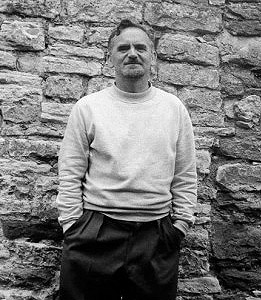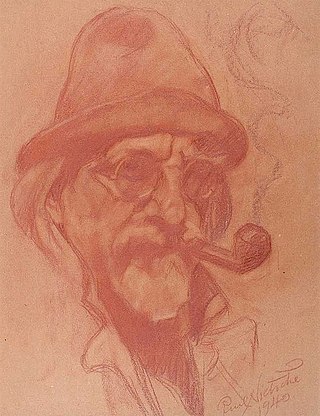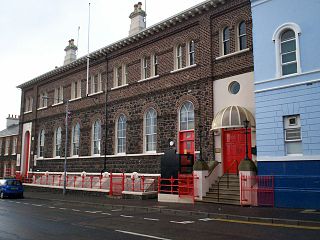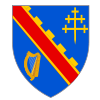Nano Reid was an Irish painter who specialised in landscape, figure painting and portraits.
One of the finest Irish painters of the century, her rich but subtly expressionist use of pigment makes her work as relevant today as when she started painting

The Ulster Museum, located in the Botanic Gardens in Belfast, has around 8,000 square metres of public display space, featuring material from the collections of fine art and applied art, archaeology, ethnography, treasures from the Spanish Armada, local history, numismatics, industrial archaeology, botany, zoology and geology. It is the largest museum in Northern Ireland, and one of the components of National Museums Northern Ireland.
Basil Joseph BlackshawHRUA, HRHA was a Northern Irish artist specialising in animal paintings, portraits and landscapes and an Academician of the Royal Ulster Academy.
Colin Middleton was a Northern Irish landscape artist, figure painter, and surrealist. Middleton's prolific output in an eclectic variety of modernist styles is characterised by an intense inner vision, augmented by his lifelong interest in documenting the lives of ordinary people. He has been described as ‘Ireland's greatest surrealist.’

William Scott was a prominent abstract painter from Northern Ireland, known for his themes of still life, landscape and female nudes. He is the most internationally celebrated of 20th-century Ulster painters. His early life was the subject of the film Every Picture Tells a Story, made by his son James Scott.
Daniel O'Neill was a Romantic painter born in Belfast, Ireland.
Neil Shawcross, RHA, HRUA is an artist born in Kearsley, Lancashire, England, and resident in Northern Ireland since 1962. Primarily a portrait painter, his subjects have included Nobel prize winning poet Seamus Heaney, novelist Francis Stuart, former Lord Mayor of Belfast David Cook, footballer Derek Dougan and fellow artists Colin Middleton and Terry Frost. He also paints the figure and still life, taking a self-consciously childlike approach to composition and colour. His work also includes printmaking, and he has designed stained glass for the Ulster Museum and St. Colman's Church, Lambeg, County Antrim. He lives in Hillsborough, County Down.
John Luke was an Irish artist. He was born in Belfast at 4 Lewis Street. The fifth of seven sons and one daughter of James Luke and his wife Sarah, originally from Ahoghill. He attended the Hillman Street National School and in 1920 went to work at the York Street Flax Spinning Company. He went on soon after to become a riveter at the Workman, Clark shipyard and whilst working there he enrolled in evening classes at the Belfast College of Art.
Deborah Brown was a Northern Irish sculptor. She is well known in Ireland for her pioneering exploration of the medium of fibre glass in the 1960s and established herself as one of the country's leading sculptors, achieving extensive international acclaim.
Carolyn MulhollandHRHA, HRUA is an Irish sculptor.
Mercy HunterHRUA PPRUA ARCA MBE was a Northern Irish artist, calligrapher and teacher. Hunter was a founding member of the Ulster Society of Women Artists, where she was later to become president and she was also a past president of the Royal Ulster Academy of Arts.
Terence Philip FlanaganPPRUA HRUA RHA MBE was a landscape painter and teacher from Northern Ireland.
Dennis Henry Osborne HRUA was a British artist and teacher who worked mainly in oil and watercolour. Osborne exhibited widely in Canada, Ireland and the UK. He was a follower of the Euston Road School and the Post-Impressionist Paul Cézanne. He was a Honorary Academician of the Royal Ulster Academy of Arts.
Jean Osborne was an artist from Northern Ireland who worked primarily in oils and watercolours.
George Galway MacCannARCA ARUA was a Northern Irish abstract painter and Modernist sculptor, writer and broadcaster. MacCann was born in Belfast, the son of monumental sculptor David and his wife Elizabeth.
Romeo ToogoodARCAHRUA was an Ulster artist and teacher who specialized in landscape painting.

Paul Nietsche was a Ukrainian artist and teacher who emigrated to Ulster in 1936 where he became a central figure on the Belfast artistic and literary scenes between the 1930s and his death in 1950.
William Robert Gordon HRUA was an influential Northern Irish landscape and portrait painter, and an educator. He was a founding member of the Ulster Arts Club and the Ulster Literary Theatre.

Lurgan Town Hall is a municipal structure in Union Street, Lurgan, County Armagh, Northern Ireland. The structure, which is primarily used as a community, arts and resource centre, is a Grade B1 listed building.

Ardress House is a country house in Annaghmore, County Armagh, in Northern Ireland. The house was owned by the Clarke, then Ensor families, including the writer and lawyer George Ensor. The estate, which includes orchards, a farm and a dairy, borders the River Tall. Collections within the house include eighteenth-century paintings and furniture. In 1959, the National Trust acquired Ardress from Captain Charles Ensor with support from the Ulster Land Fund.







